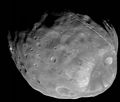Fexeiro:Phobos colour 2008.jpg

Tamanho desta antebison: 636 × 600 píxeles. Outras resoluçones: 255 × 240 píxeles | 509 × 480 píxeles | 815 × 768 píxeles | 1 086 × 1 024 píxeles | 2 172 × 2 048 píxeles | 3 500 × 3 300 píxeles.
Fexeiro oureginal (3 500 × 3 300 píxeles, tamanho: 2,72 MB, tipo MIME: image/jpeg)
Stórico de l fexeiro
Clique an ua data/hora para ber l fexeiro tal cumo el staba naquel sfergante.
| Data i hora | Amostra | Tamanho | Outelizador | Comentairo | |
|---|---|---|---|---|---|
| atual | 03h10min de 2 de abril de 2018 |  | 3 500 × 3 300 (2,72 MB) | Kaldari | more margin on right side |
| 04h47min de 13 de nobembre de 2008 |  | 3 374 × 3 300 (2,7 MB) | Fir0002 | == Summary == {{Information |Description=Colour image of Phobos, imaged by the Mars Reconnaisance Orbiter in 2008 |Source=NASA |Date=9 April 2008 |Location=http://www.nasa.gov/mission_pages/MRO/multimedia/pia10368.html |Author=NASA/J |
Lhigaçones de l fexeiro
Esta páigina lhiga este fexeiro:
Outelizaçon global dun fexeiro
Las seguintes wikis outelizan este fexeiro:
- Outelizaçon na af.wikipedia.org
- Outelizaçon na an.wikipedia.org
- Outelizaçon na ar.wikipedia.org
- المريخ
- فوبوس
- قمرا المريخ
- ويكيبيديا:صور مختارة/الفضاء والكون/نظرة إلى الأعلى
- قائمة أجرام المجموعة الشمسية مرتبة حسب الحجم
- بوابة:علم الفلك/صورة مختارة
- بوابة:المريخ/مقالة مختارة/أرشيف
- بوابة:المريخ/مقالة مختارة/2
- قائمة الأقمار الطبيعية
- خط زمني لاكتشاف كواكب المجموعة الشمسية وأقمارها
- ويكيبيديا:ترشيحات الصور المختارة/القمر فوبوس
- ويكيبيديا:صورة اليوم المختارة/أغسطس 2019
- قالب:صورة اليوم المختارة/2019-08-03
- بوابة:علم الفلك/صورة مختارة/73
- معسكر قاعدة المريخ
- ويكيبيديا:صورة اليوم المختارة/يناير 2022
- قالب:صورة اليوم المختارة/2022-01-04
- Outelizaçon na ary.wikipedia.org
- Outelizaçon na arz.wikipedia.org
- Outelizaçon na as.wikipedia.org
- Outelizaçon na azb.wikipedia.org
- Outelizaçon na az.wikipedia.org
- Outelizaçon na be-tarask.wikipedia.org
- Outelizaçon na be.wikipedia.org
- Outelizaçon na bg.wikipedia.org
- Outelizaçon na bh.wikipedia.org
- Outelizaçon na bn.wikipedia.org
- Outelizaçon na bn.wikibooks.org
- Outelizaçon na bs.wikipedia.org
Ber la outelizaçon global deste fexeiro.




